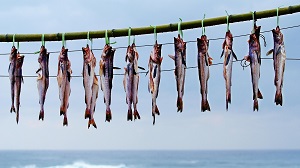![]() Storage and Preservation Issues is a news and information topic monitored and covered by: Prepper Watch – Food Concerns
Storage and Preservation Issues is a news and information topic monitored and covered by: Prepper Watch – Food Concerns
Introduction
In the uncertain world of prepping, one of the most critical concerns for preppers is the ability to store and preserve food. Whether you’re preparing for natural disasters, economic collapse, or any other scenario that could disrupt the supply chain, proper food storage and preservation can make the difference between survival and failure.
Insufficient infrastructure for food storage and preservation leads to spoilage, which can waste valuable resources and increase the risk of malnutrition or foodborne illnesses. Therefore, preppers must take a proactive approach to ensure that their food supplies remain viable for extended periods.
In this 10-page blog, we will delve into the different strategies, tools, and methods preppers use to prepare for food storage and preservation issues, ensuring that they can endure long-term isolation without relying on fragile infrastructure.
Understanding the Importance of Food Storage
Before diving into the different methods of food storage, it’s essential to understand why this step is so crucial. Food storage ensures that you have access to critical nutrients and calories in a crisis, especially when stores are closed, deliveries are delayed, or crop yields are unpredictable. Effective food storage reduces reliance on grocery stores and helps mitigate supply chain disruptions.
In addition to preserving food for nutrition, proper storage also helps avoid the problems associated with spoilage. Spoiled food can lead to a range of problems, including foodborne illnesses, hunger, and loss of morale. With a well-thought-out plan for food storage, preppers can not only extend the shelf life of their food but also increase the overall security of their food supply.
Building a Stockpile: The Foundation of Food Storage
One of the first steps in prepping for storage and preservation issues is building a stockpile of food that can last for months or even years. A stockpile should include a wide variety of food types, including:
- Canned Goods: Canned vegetables, fruits, meats, and soups are essential because they last for several years without refrigeration.
- Dried Foods: Freeze-dried meals, dehydrated vegetables, fruits, and jerky provide lightweight options that are easy to store and prepare.
- Grains and Legumes: Rice, pasta, beans, and oats are cost-effective, nutritious staples that can be stored for long periods.
- Powdered Dairy and Eggs: Powdered milk and eggs are ideal for long-term storage as they can be rehydrated when needed.
A key element of building a stockpile is ensuring that it consists of foods that are easy to store, won’t spoil quickly, and have long shelf lives. Moreover, having a variety of food types ensures that your nutritional needs are met, and you can rotate the stockpile to keep it fresh.
Proper Storage Conditions
Once you’ve stockpiled your food, the next critical step is storing it in an environment that preserves its quality for as long as possible. Preppers must consider several factors, such as temperature, humidity, light, and air, when storing food.
- Temperature: A cool, dark place is the ideal location for storing most foods. The optimal temperature range for long-term food storage is between 50°F and 70°F (10°C to 21°C). Hotter temperatures can accelerate the degradation of food, especially oils, grains, and dehydrated foods.
- Humidity: Excess moisture can lead to mold growth, rusting, and the degradation of food, while dry conditions can cause some foods to become brittle. Aim for humidity levels of about 15% to 30% in your storage area.
- Light: Direct exposure to sunlight can cause food to deteriorate more quickly by breaking down vitamins and increasing the risk of spoilage. Store food in opaque containers or in dark, cool areas away from light.
- Air: Exposure to air, particularly oxygen, can lead to oxidation and the degradation of nutrients. Vacuum-sealing and airtight containers are vital in preventing air exposure, which helps preserve the freshness of food.
Advanced Food Preservation Methods
In addition to stockpiling and proper storage conditions, preppers often use advanced food preservation techniques to extend the life of their food further.
Canning
Canning is one of the most popular preservation methods among preppers. The process involves sealing food in airtight containers, which are then heated to kill bacteria, yeasts, and molds that could cause spoilage. There are two main types of canning: water bath canning and pressure canning.
- Water Bath Canning: Used for high-acid foods like fruits, jams, and pickles.
- Pressure Canning: Required for low-acid foods like meats, vegetables, and poultry.
Canned food can last for up to 1-2 years, and in some cases, even longer, if stored properly. Preppers often rotate their canning stocks to ensure the oldest items are used first.
Freezing
While freezing requires an ongoing energy source, it can be a very effective short- to medium-term food preservation method. Preppers with access to generators or solar-powered systems can freeze perishable foods like meat, vegetables, and fruits to extend their shelf life for several months to a year. However, freezers need to be properly maintained, and preppers must ensure that their power sources are reliable.
Dehydration
Dehydrating food removes the moisture, which prevents the growth of spoilage-causing organisms. There are several ways to dehydrate food, including air drying, sun drying, and using a food dehydrator. This method is particularly useful for fruits, vegetables, meats, and herbs. Dehydrated foods can last for several months to years if stored in airtight containers in a cool, dry environment.
Fermentation
Fermenting foods like sauerkraut, kimchi, and yogurt is another ancient preservation method that preppers can use to store vegetables and dairy. Fermented foods provide not only long-term preservation but also important probiotics that support gut health, which is essential in survival situations.
Water Storage and Preservation
Along with food, water is another essential resource that preppers must ensure is available in adequate supply. Many food preservation methods require water, and in disaster situations, having access to clean water is paramount. Preppers should invest in water storage containers such as 55-gallon barrels and water bladders, ensuring that they rotate the water supply regularly to prevent it from becoming stale or contaminated.
In addition to storing water, preppers should also learn purification methods, including using water filters, boiling, and water purification tablets, to ensure that water can be made safe for consumption during emergencies.
Long-Term Preservation Technologies
As food preservation continues to evolve, preppers can benefit from adopting modern technologies to ensure the long-term storage of food.
Freeze-Drying
Freeze-dried food is one of the most reliable and space-efficient options for long-term food storage. Unlike traditional dehydration, freeze-drying preserves food by removing moisture while maintaining its shape, taste, and nutritional content. Preppers can purchase freeze-dried meals or purchase a home freeze-drying machine for bulk food preservation. Freeze-dried foods can last for 10 to 25 years, making them an ideal option for long-term survival.
Oxygen Absorbers and Vacuum Sealing
Using oxygen absorbers in sealed containers helps to prevent oxidation, which is one of the primary causes of spoilage in long-term storage. Vacuum sealing also eliminates air, ensuring that food stays fresh for longer. These methods are particularly useful for grains, legumes, and dehydrated foods.
Preserving Nutrient Density
As you prepare your food storage and preservation plan, it is important to prioritize nutrient-dense foods. While calorie-dense foods are important for survival, ensuring that your stockpile includes a variety of vitamins and minerals is essential for maintaining health over extended periods.
The Role of Community in Food Storage
While individual preparedness is important, preppers often recognize the value of community when it comes to food storage. Forming mutual assistance groups (MAGs) or prepper communities can increase the chances of survival by pooling resources and knowledge. Communities can work together to share storage space, resources, and even trade preservation methods.
Regular Maintenance and Rotating Your Stock
A prepper’s food storage plan isn’t static; it requires regular maintenance to ensure that it remains effective. This includes rotating stock, checking for expired items, and replenishing supplies as needed. Keeping a food inventory and regularly checking expiration dates will help preppers stay ahead of spoilage and make sure that their stored food remains usable.
Conclusion: The Key to Long-Term Survival
Preparing for storage and preservation issues is a vital part of a prepper’s strategy to ensure food security in times of crisis. By using a combination of strategies such as proper storage conditions, advanced preservation methods, water storage, and community involvement, preppers can increase their chances of surviving long-term isolation or disruption of infrastructure.
With careful planning, regular maintenance, and a focus on nutrient-dense foods, preppers can ensure that they have the resources they need to weather any storm, economic collapse, or disaster that may come their way.

